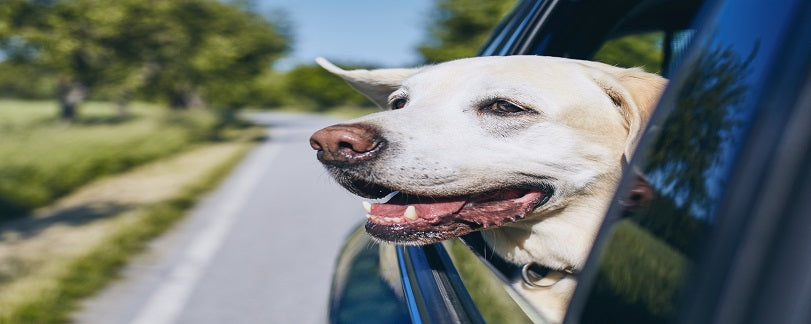
The Best Way for Dogs to Travel in Cars
Share
Your dogs must be restrained or contained in the car. Not only is this sensible, but it is also the law! You could risk being prosecuted for driving without due care and attention, or dangerous driving, in the event of a car crash. There are three main ways to restrain your pets in the car, and we will take a look at each of them. You can use dog guards, crates, or seat belt harnesses. As with all options, there are pros and cons to each of them. It will depend on your dog and your circumstances, take your time to make the best decision for you and your dogs so that you can all enjoy safe, legal car rides to exciting destinations!
The Law on Travelling in The Car With Your Dog in the UK
The Highway Code states that drivers must “make sure dogs and other animals are suitably restrained.” It does not specify precisely how you must do this, but it is very clear that your pets must be restrained. Even if it were not the law, it is sensible to secure your pets. Dogs and other pets can be very distracting, wanting to be near you, nudging you, wanting to climb on your lap. None of which makes for very safe driving. In the unfortunate event of a car crash, an unrestrained dog could injure itself or others, as well as being hard to control if scared or aggressive in the aftermath of a crash. Don't break the law, or put yourself and your family at risk.
Preparing your Pet for the Journey
Depending on your choice of how best to travel with your dog, your dog may require different equipment. If your dog is travelling in a crate, then the crate will need to be in the car ready. If you are using a seat belt harness, then make sure your dog has a harness on so that you can safely attach him to the seat belt. Do not attach him by his collar to a seat belt harness. If he is travelling in the boot with a dog guard in place, then having a bed or a blanket will make it more comfortable and pleasant for him.
Safety Measures Inside Cars
Always keep your pet in their safe travelling place. Do not remove them from their crate, or unclip them. If your dog becomes distressed during travelling, then look for a safe place to pull over, where you can remove your dog from the car in a safe environment. Remember that dogs can be reactive and extremely strong when they are scared, so ensure that your dog has a good quality lead and collar on when you take him out of the car.
Basic Etiquette and Training for Car Travel
It is easier and safer for everyone if your dog is happy in the car. This training starts when your dog is a puppy, with regular, short car journeys to introduce him to the concept of car travel. If dogs are only taken to the vet in the car, they can have bad associations with the car, which can lead to problems when travelling. Make sure that your dog is regularly taken to enjoyable destinations in the car so that they are happy to travel in the car. Teaching your dog a “stay” command will give you more control while getting him in and out of the car. This is particularly useful for dogs who travel in the boot with a dog guard. A firm hand signal and voice command before you open the boot will prevent your dog from jumping out the moment the boot is opened.
On-the-Road Practices
Remember that when you are driving, your concentration should be on the road. Sadly, accidents can happen in split seconds of inattention. Do not turn around to check on your pet, or use your rearview mirror to watch them. If you want to check how your pet is travelling, ask a friend to come in the car with you to keep an eye on your pet.
Temperature and Ventilation
Dogs die in hot cars. Never leave your dog in a car during a hot summer's day. Cars can rapidly heat up and reach a lethal temperature extremely quickly. During travel, ensure that either the air conditioning is keeping the car at a safe temperature, or that you have sufficient airflow through the car to keep your dog cool.
Making Frequent Stops
While some dogs will quite happily get into the car and go to sleep, not waking up till you reach your destination, not all dogs are this laid back. If your canine companion gets restless during travel, you will need to plan your route with frequent safe stops.
Handling Dogs and Car Sickness
Puppies can be prone to car sickness, but they can grow out of it. Keep car trips short to build tolerance, and don't feed them just before travel. If your dog struggles with car sickness, and you need to take a long trip, speak to your vet, as there are medications that can help.
Long-Distance Travel Tips
Hopefully, before you take a long car trip, you will have taught your pet how to behave in the car and acclimatised him to car travel by making shorter trips. If you are planning a long trip, make sure that you consider your pet. He will need stops for drinks, and toileting, so plan your stops where there is somewhere to walk him around.
Get Ready to Enjoy Your Car Travel and Days Out
Being able to travel with your pets opens up a world of exciting possibilities. There are so many amazing walks, and fantastic dog-friendly days out, that with some planning you can take your dog with you. Dogs, generally, don't like to be left for long periods, so make sure that they are happy travellers, and then they can come with you on your adventures!
Choose the Best Dog Kennel for Your Dog’s Downtime
After a busy day adventuring with you, your dog will want nothing more than a safe and cosy place to rest his head and catch up on some well-earned sleep. Here at Dog Kennels Direct, we have a range of outdoor dog kennels, which will give your dog the space and comfort to unwind and relax after a day full of excitement and adventure. Investing in a high-quality dog kennel will give you a dedicated space for your dog, ideal for leaving him for longer periods, or keeping him safe while you have visitors. Take a look at our extensive range of dog kennels, or call our friendly and helpful team for advice on 01942 316 431
Read related articles:



